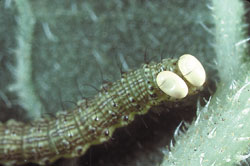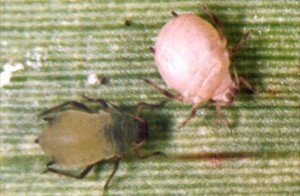A parasite is an organism that lives on or in the body of another organism (the host) during some part of its lifecycle e.g. parasitic mites.
Most beneficial insects found in grain production systems are parasitoids – organisms that spend a large part of their lifecycle attached to or within the organism (in a relationship that is essentially parasitic). However, unlike a true parasite, a parasitoid ultimately sterilises, kills and/or consumes its host.
Most beneficial insect parasitoids are wasps or flies.
Unlike predators that immediately kill or disable their prey, pests attacked by parasitoids die more slowly. Some hosts are paralysed, while others may continue to feed or even lay eggs before they die. Parasitoids often complete their life cycle more quickly and increase their numbers faster than many predators. Parasitoids can therefore be the more dominant and effective natural enemy of some pest insects, but their presence may not be obvious. To determine the extent of parasitism, insect pests may need to be dissected or reared to see if adult parasitoids emerge.
Characteristics of parasitoids
- Often highly specialised and host specific
- Tend to be smaller than the host
- Only the female searches for the host to lay eggs. Eggs are usually laid in, on, or near host
- Immature parasitoids remain on or in host; adults are free-living and mobile
- Sometimes multiple parasitoids may emerge from one pest.
- Highly susceptible to insecticides , especially adults
- Adult forms often require an alternative food source such a pollen or nectar
Importance of parasitoids in insect management
- Pest management with parasitoids costs nothing
- At low pest densities, parasitoids can suppress infestations to below economic thresholds
- Parasitoids reduce the number of pests surviving to the next generation
- They are compatible with other biological control agents (diseases and predators)
- Parasitoids are host specific
- Some parasitoids affect feeding behaviour e.g. parasitised larvae eat less than healthy ones
- Parasitoids are efficient host searchers – they can find hosts even when pest densities are low
Parasitoid life cycle and terminology

Trichogramma egg parasite
Parasitoids are described according to the life stage of the host that they attack. For example, egg parasitoids parasitise eggs. Life stages and parasitoids include:
- Egg parasitoids e.g. Trichogramma & Telenomus wasps
- Larval parasitoids e.g. Netelia producta (Orange caterpillar parasite) & Tachinid flies
- Larval – pupal parasitoids e.g. Heteropelma scaposum (Two-toned parasite)
- Pupal parasitoid –Ichneumon promissorius (Banded caterpillar parasite)
Some parasitoid species attack one stage but do not emerge from their host until much later. An example of this is the larval-pupal parasitoid Heteropelma wasp that lays its eggs inside the helicoverpa caterpillar, but the adult wasp does not emerge until after the caterpillar has pupated.
Benefits of parasitoids
They are usually extremely well adapted to their natural host and are very good at finding them even when densities of the host are relatively low
Limitations of parasitoids
- They are often (but not always) host-specific and often will attack only one species of pest.
- They are generally more delicate than predators and hence more vulnerable to pesticides.
Because parasitoids spend most of their life cycle developing within their prey, they are less visible than predators, and their performance may be underestimated as a result.
Parasitoids can be parasitised by other parasitoids. This is known as hyperparasitism – a natural and common occurrence which can reduce the effectiveness of some beneficial species. Little can be done to manage hyperparasitism.
Evidence of parasitism
- Look for evidence of an exit hole in the host
- Dissect samples (may be difficult with very small insects)
- Rear pests in an insect proof cage to see if parasitoids emerge
- Check for deformed insects e.g. caterpillars or mummified/bloated insects such as aphids
- Look for wasp cocoons near caterpillars
Parasitoid susceptibility to pesticides
Parasitoids are often more susceptible to insecticides than predators. Adult parasitoids are usually more susceptible than their hosts. Immature parasitoids, especially if protected within the egg of their host or in their own cocoon, may tolerate pesticides better than adults, but immature parasitoids will usually die if their host is killed.
To improve the abundance and diversity of beneficial insects – consider native vegetation on the farm as a part of a pest management strategy.


